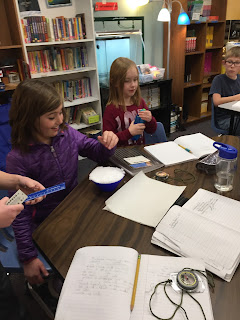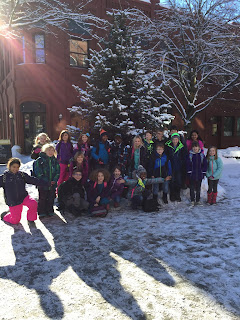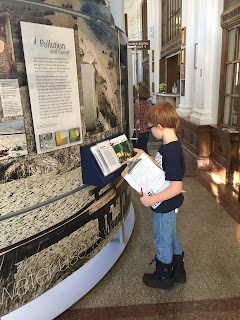 |
Concentrating to find their homes, and
then write understandable
directions. |
 |
| Working with a partner, the students had to find their homes and give directions to each other of how to travel there using measurements of scale, cardinal directions, street names. The fun will be seeing if the other students can follow these directions. :) |
 |
Rough drafts for the Small Book Project: first in the notebook and using the straight edge
for creating the book size and making lines for their own writing. Creating their own simile for either Horace or Jemmy that will be in their book. In the background, Ms. Omni making rounds to help the kids figure out how the book is put together. This project totally stretched their brains. We will be using the rubric in the coming weeks to assess how they did. |
 |
| Practice, practice, practice... |
 |
| Ms. Omni did a fantastic job sharing her art and skills. She brought in other projects she had completed in completing books. The kids were wowed and she was patient and her creativity really inspired them. |
 |
| Redoing--revising is the best way to learn. It is essential to have that one on one time to find out what it is that each student needs to do in order to understand and create the best work they can. The rewarding part is how engaged the kids are and how much they gain in the slow process of manipulating materials. |
 |
| Here is the list of how the book was organized. This will be the guide for their assessment. |
 |
| While the book project was going on, the kids worked on science from their Super Science magazine--citing information. The math was to use the program on line and work through the end of the Chapter 2 material. They turned in this work so that I could have a look at how they explain their thinking. That is the key to math, or with any type of work, the kids needs to be able to articulate their answer and the process they used to get there. Learning to put into words takes a lot of practice. We are finishing up addition and subtraction and then on to multiplication. |

 |
| 3 stations of work for several days-- math, science, Readers' Workshop |


These pictures are from doing Pointillism. We used Q-tips, experimented with toothbrushes and in general, learned how the artists created their masterpieces. In the Whipping Boy, Sid Fleischman had some really interesting Pointillism illustrations. We looked at the science of the time--late 1800s--as it was a time when color integration and mixing styles were changing. The kids leaned how prisms work and that white light is the all the color waves together and saw that each has a different wavelength. Science knowledge has influenced art and then the artists tried to incorporate what they had learned. This link about
George Seurat
is some of the information that was taught.
 |
| Everyone enjoyed learning a new skill and gained an appreciation of the time to create the Pointillism pictures |
 |
| Readers as Leaders-- We got our t-shirts and getting set for a picture. They were so funny watching them get set for the shots I took. :) |






 These pictures are from doing Pointillism. We used Q-tips, experimented with toothbrushes and in general, learned how the artists created their masterpieces. In the Whipping Boy, Sid Fleischman had some really interesting Pointillism illustrations. We looked at the science of the time--late 1800s--as it was a time when color integration and mixing styles were changing. The kids leaned how prisms work and that white light is the all the color waves together and saw that each has a different wavelength. Science knowledge has influenced art and then the artists tried to incorporate what they had learned. This link about George Seurat
These pictures are from doing Pointillism. We used Q-tips, experimented with toothbrushes and in general, learned how the artists created their masterpieces. In the Whipping Boy, Sid Fleischman had some really interesting Pointillism illustrations. We looked at the science of the time--late 1800s--as it was a time when color integration and mixing styles were changing. The kids leaned how prisms work and that white light is the all the color waves together and saw that each has a different wavelength. Science knowledge has influenced art and then the artists tried to incorporate what they had learned. This link about George Seurat













































